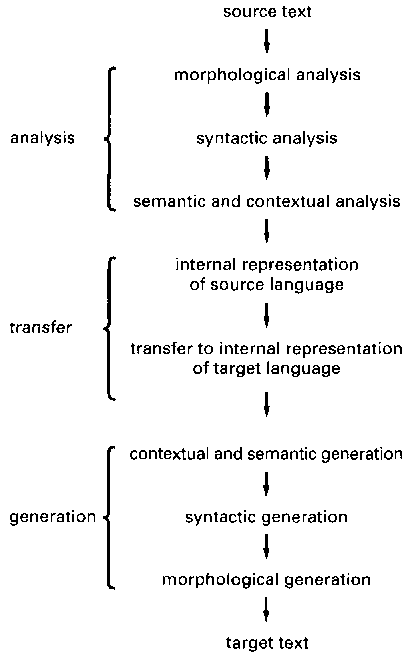In the 17 th century and thanks to René Descartes, who thought about connecting two words in different languages to a unique symbol, and later in the 20 th century with the development of the Georgetown experiment; the translation issue was born.
Machine Translation (MT) is used to translate texts from one language to another. This process is put into practise by means of a machine, there is no human translation, only in the creation of the machine: the translator will be ‘taught’ the connection existent between a universal symbol and its transcription in different languages. This task is complicated due to the ambiguity of human languages.

Some important examples of machine translation are: Lucy, Systran, ProMT, OpenTrad, Google translate, Yahoo! Babel fish…
If Machine Translation is carried out by a machine, altough some human aid does exist in the programming of the translator and in the preediting and postediting, Machine-Aided Human Translation (MAHT) is the opposite way. In MAHT, also called Computer-Aided Translation(CAT), a human performs the translation, with the support offered by computer tools.
Three types of MAHT do exist, according to the different type of users:
- Specific Software Environments designed for Professional Translators Working In Teams: it is the case of competent translators working in teams and connected with a local network. They count on workstations which offer them tools (integrated in the text processor)to access a bilingual terminology and a translation memory and to submit parts ot the text to an MT server. These tools the professional translators use are: Trados (MultiTerm), IBM (Translation Manager), SITE-EuroLang (EuroLang Optimizer).
- Environments for Independent Professional Translators: translators are freelance and they are asked to present the translate text in the same format of the source documents. They use tools such as: Mercury/Termex by LinguaTech, a resident program for PCs, and WinTool.
- Tools for Occasional Translators: they are helped by dictionaries, conjugators, style checkers… they don’t work with translation memory. Tools: SISKEP, Ambassador by Language Engineering.
REFERENCES
– Machine translation. (2009, May 16). In Wikipedia, The Free Encyclopedia. Retrieved 17:20, May 19, 2009, from http://en.wikipedia.org/w/index.php?title=Machine_translation&oldid=295950237
– ‘Machine-aided Human Translation’ by Christian Boitet, Université Joseph Fourier, Grenoble, France. Retrieved 17: 34, May 19, 2009, from http://cslu.cse.ogi.edu/HLTsurvey/ch8node6.html
– ‘Machine Translation: The Disappointing Past and Present’ by Martin Kay, Xerox Palo Alto Research Center, Palo Alto, California, USA. Retrieved 17:37,May19,2009,from http://cslu.cse.ogi.edu/HLTsurvey/ch8node4.html#SECTION82
– Computer-assisted translation. (2009, May 1). In Wikipedia, The Free Encyclopedia. Retrieved 17:39, May 19, 2009, from http://en.wikipedia.org/w/index.php?title=Computer-assisted_translation&oldid=294759999